
By Kasey Cantwell - NOAA Office of Ocean Exploration and Research
April 29, 2015
We see so many amazing things every day on NOAA Ship Okeanos Explorer that it is often difficult to pick which one image to use to summarize the day in the daily updates or what three or four images to use for mission logs. Our team collects terabytes of primarily imagery data every expedition, but not all of those images end up on our website. Below are some of my favorite images that hadn't yet had their 15 minutes of fame.
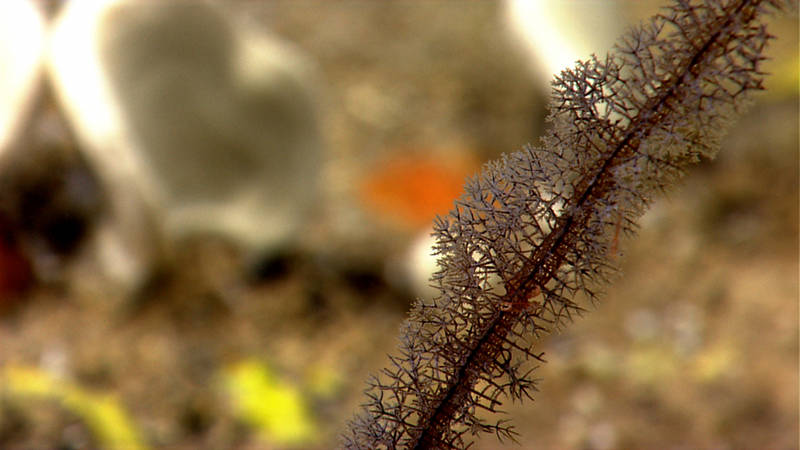
Translucent shrimp bodies can mimic the translucent appearance of a polyp which makes them all the more difficult to see. Image courtesy of NOAA Office of Ocean Exploration and Research. Download larger version (jpg, 1.4 MB).
I am constantly amazed by the quality of pictures that the Okeanos Explorer team gets of the geology and life on the seafloor. What is even more impressive is how our team of pilots and videographers spot some very small or difficult-to-see animals from far away and manage to get great pictures of them. Often organisms who are small will disguise themselves to look like their habitat or to look like something else entirely, with the goal of going unnoticed by predators.
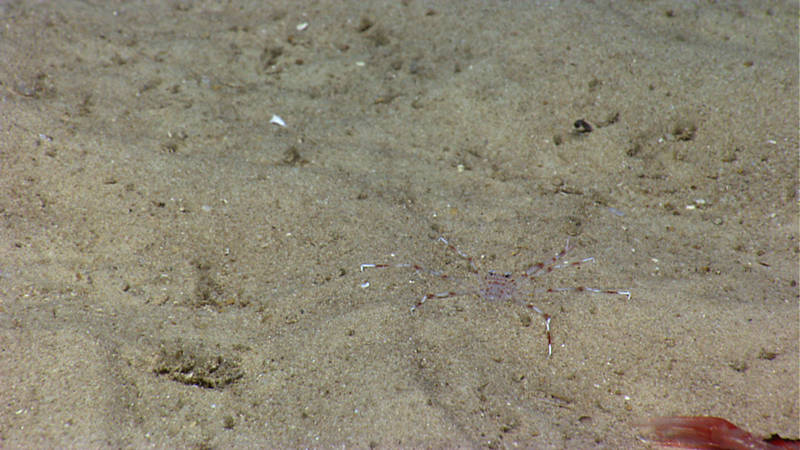
Can you spot the crab on the seafloor? Image courtesy of NOAA Office of Ocean Exploration and Research, Océano Profundo 2015: Exploring Puerto Rico’s Seamounts, Trenches, and Troughs. Downloadlarger version (jpg, 1.6 MB).
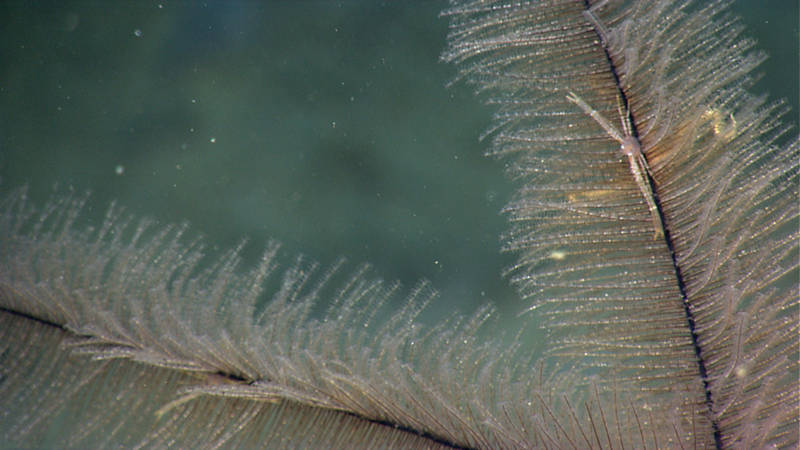
This tiny crab almost looks like another branch on this black coral. Image courtesy of NOAA Office of Ocean Exploration and Research, Océano Profundo 2015: Exploring Puerto Rico’s Seamounts, Trenches, and Troughs. Download larger version (jpg, 14 KB).
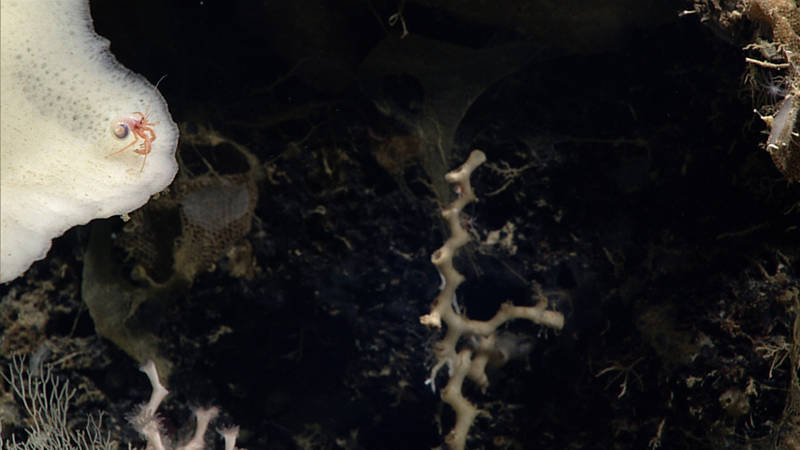
Without the powerful zoom capabilities on our main camera, it's possible that we would have missed this tiny hermit crab entirely! Image courtesy of NOAA Office of Ocean Exploration and Research, Océano Profundo 2015: Exploring Puerto Rico’s Seamounts, Trenches, and Troughs. Download larger version (jpg, 1.1 MB).
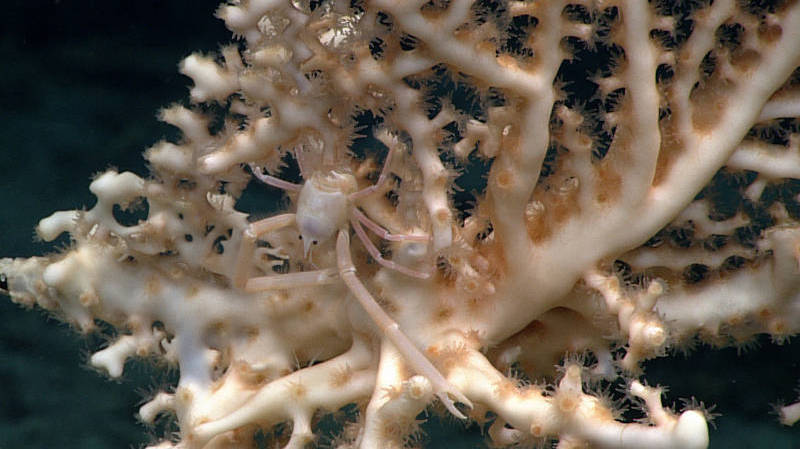
Unless you look carefully, it’s possible to overlook this squat lobster who perfectly matches the color of its coral home. Image courtesy of NOAA Office of Ocean Exploration and Research, Océano Profundo 2015: Exploring Puerto Rico’s Seamounts, Trenches, and Troughs. Download larger version (jpg, 1.0 MB).
An isopod is captured in Seirios' view, dancing above D2. Video courtesy of NOAA Office of Ocean Exploration and Research, Océano Profundo 2015: Exploring Puerto Rico’s Seamounts, Trenches, and Troughs. Download (mp4, 3.5 MB)
Although we usually talk about remotely operated vehicle (ROV) Deep Discoverer, or "D2," as the main vehicle, our ROV system actually has two vehicles. Aside from providing additional light and absorbing the ship's motion, Seirios, the second half of the two-body ROV system, gives us an additional perspective.
Using the view of Seirios, we are sometimes able to see animals and geologic features that are in D2’s peripheral view or outside of D2’s view all together. We also sometimes see animals moving away from D2’s bright lights or animals who don’t reside on the seafloor. My favorite example of the odd-looking isopod in the video above. It has paddle-like appendages, but unfortunately it swims so fast, that it is hard to get a good image of it.
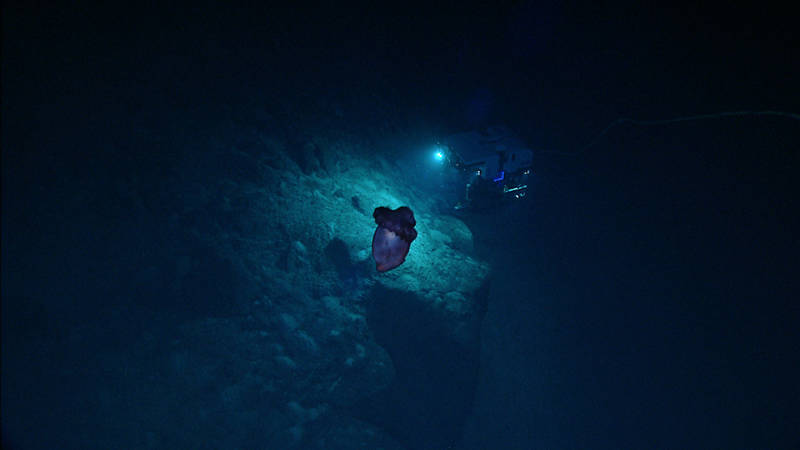
While Seirios usually focuses on D2, this swimming sea cucumber stole the spotlight for a minute while D2 investigated an outcrop during our dive at Pinnacles. Image courtesy of NOAA Office of Ocean Exploration and Research, Océano Profundo 2015: Exploring Puerto Rico’s Seamounts, Trenches, and Troughs. Download larger version (jpg, 1.2 MB).
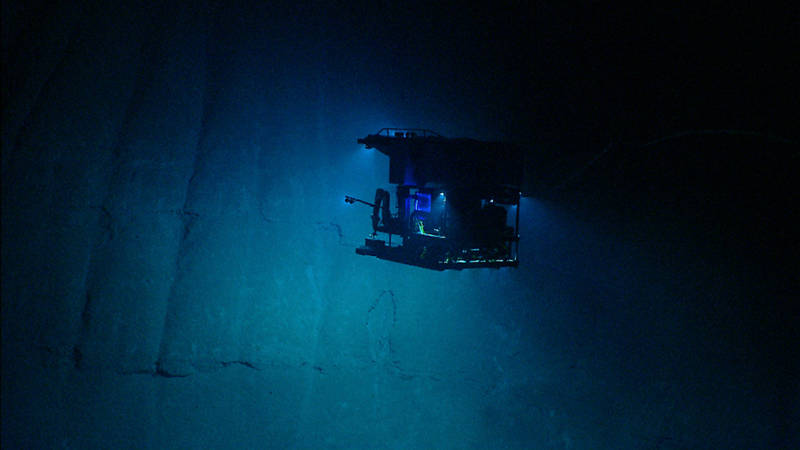
As the vehicles climb a steep slope along the wall of Guayanilla Canyon, views like this from Seirios allow our pilots to see what is ahead and look out for any upcoming hazards. The secondary view from Seirios also gives our geologists a great sense of scale for their surroundings. From D2’s perspective, without Seirios, you would only be able to see a small portion of the feature. Image courtesy of NOAA Office of Ocean Exploration and Research, Océano Profundo 2015: Exploring Puerto Rico’s Seamounts, Trenches, and Troughs. Download larger version (jpg, 1.4 MB).
One of the things that makes RƒOV cruises on Okeanos Explorer different than others is the emphasis that is placed on obtaining the best possible imagery. Whether that is quickly capturing something as it darts by or if it is throughly documenting every associate on a large colony of coral, our videographers and pilots are amazing! Below are some of my favorite shots from this cruise.
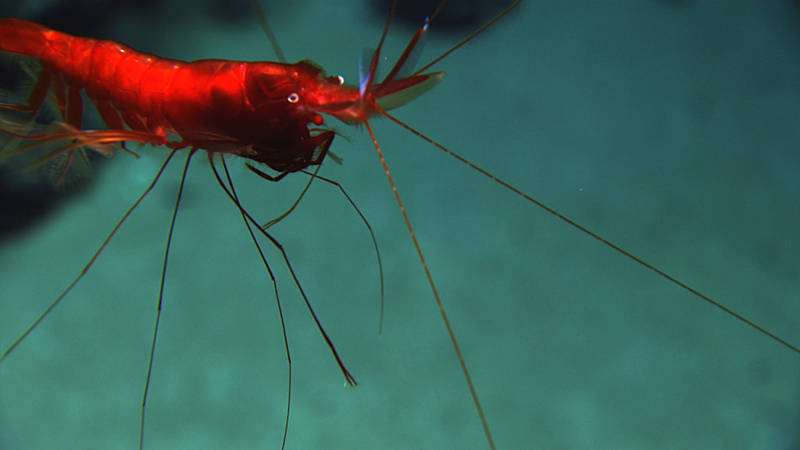
Red is one of the first colors of light to disappear at depth, so several animals in the deep sea use this color to “disappear.” When we document organisms with the ROVs, we are able to see these animals in a way that wouldn’t be possible without our artificial lights. In the dark of the deep sea, this shrimp would appear black. Image courtesy of NOAA Office of Ocean Exploration and Research, Océano Profundo 2015: Exploring Puerto Rico’s Seamounts, Trenches, and Troughs.. Download larger version (jpg, 1.2 MB).

Sea urchins were fairly common throughout the expedition, but this one was particularly interesting due to its barbed spines and brittle star associates. Image courtesy of NOAA Office of Ocean Exploration and Research, Océano Profundo 2015: Exploring Puerto Rico’s Seamounts, Trenches, and Troughs. Download larger version (jpg, 1.5 MB).
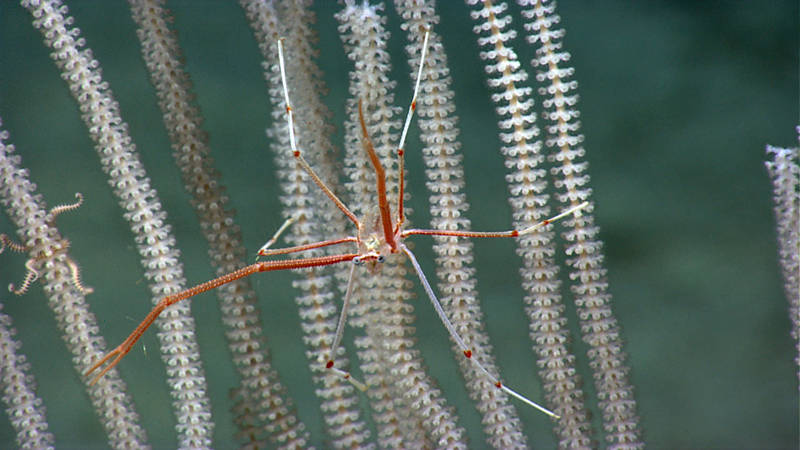
We observed this type of squat lobster a couple times during the expedition, but our science team still hasn’t been able to pin down exactly what species it is. Image courtesy of NOAA Office of Ocean Exploration and Research, Océano Profundo 2015: Exploring Puerto Rico’s Seamounts, Trenches, and Troughs.. Download larger version (jpg, 1.4 MB).
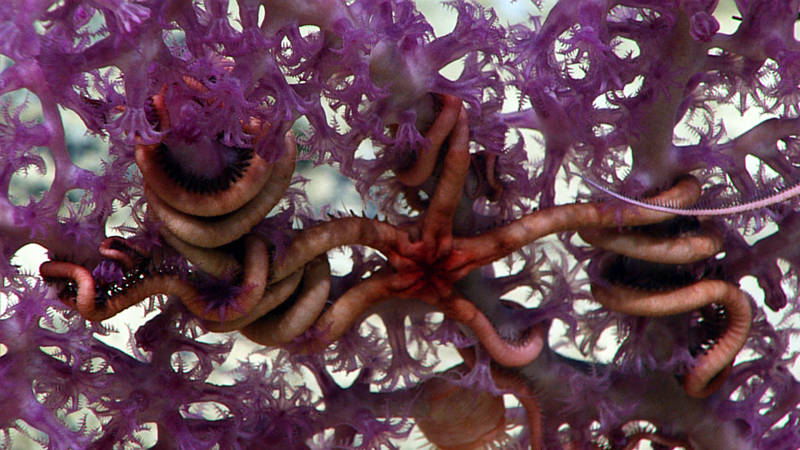
Sea brittles were fairly common throughout the expedition, but this one was particularly interesting due to its barbed spines and brittle star associates. Image courtesy of NOAA Office of Ocean Exploration and Research, Océano Profundo 2015: Exploring Puerto Rico’s Seamounts, Trenches, and Troughs. Download larger version (jpg, 745 KB).
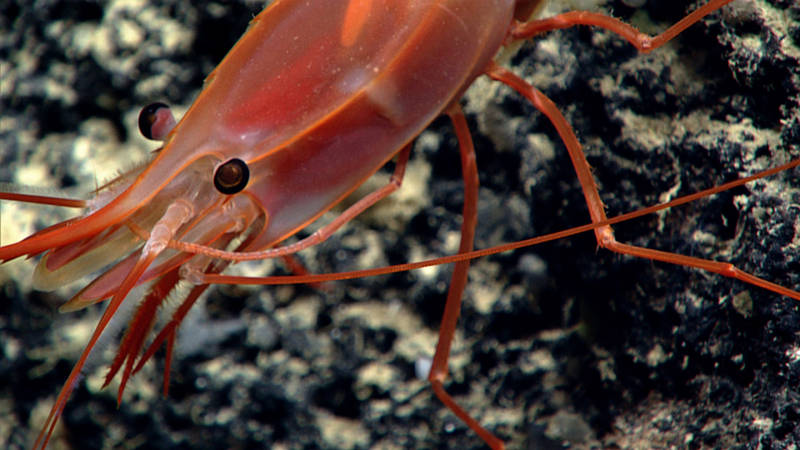
This shrimp was really exciting! We spent five minutes documenting this shrimp’s grooming behavior. Here it is just beginning to groom its rostrum after finishing with its eyes and carapace. I had never seen a shrimp groom itself before, nor one with such a flexible appendage to do so. Image courtesy of NOAA Office of Ocean Exploration and Research, Océano Profundo 2015: Exploring Puerto Rico’s Seamounts, Trenches, and Troughs.. Download larger version (jpg, 1.3 MB).
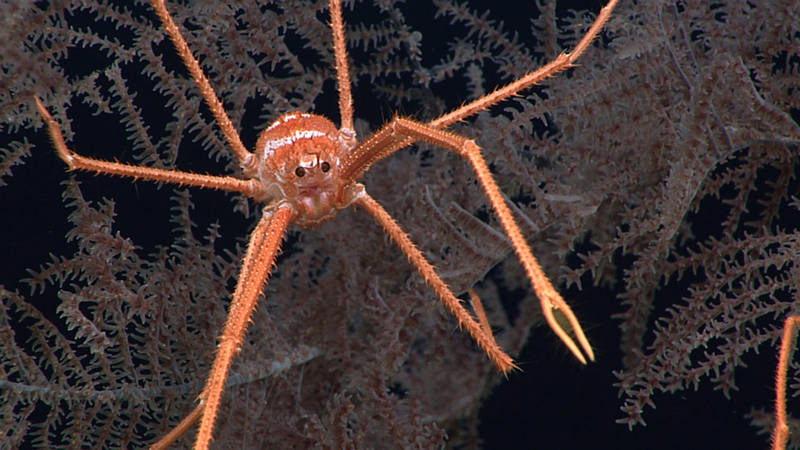
Squat lobsters are some of my favorite deep-sea organisms to see during a dive, as they always look so delightfully awkward. This squat lobster is perched on a large colony of black coral. Image courtesy of NOAA Office of Ocean Exploration and Research, Océano Profundo 2015: Exploring Puerto Rico’s Seamounts, Trenches, and Troughs. Download larger version (jpg, 1.3 MB).